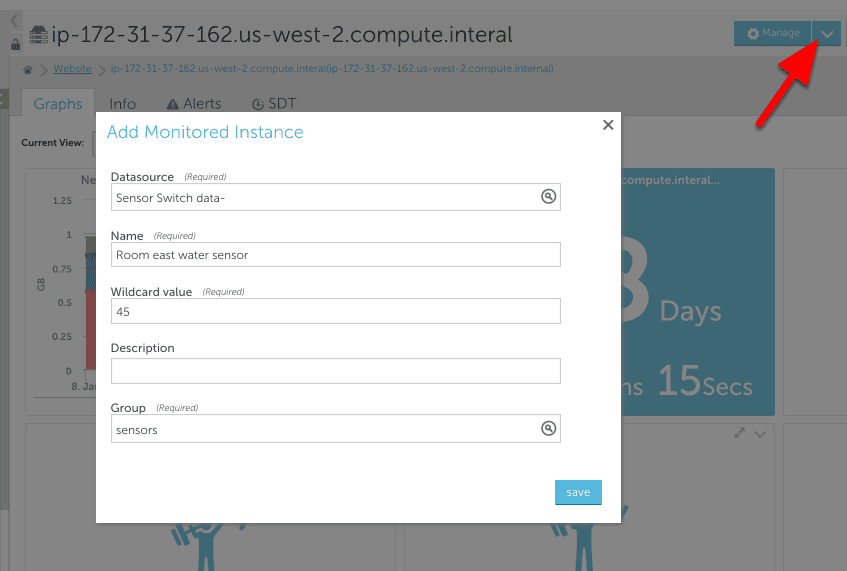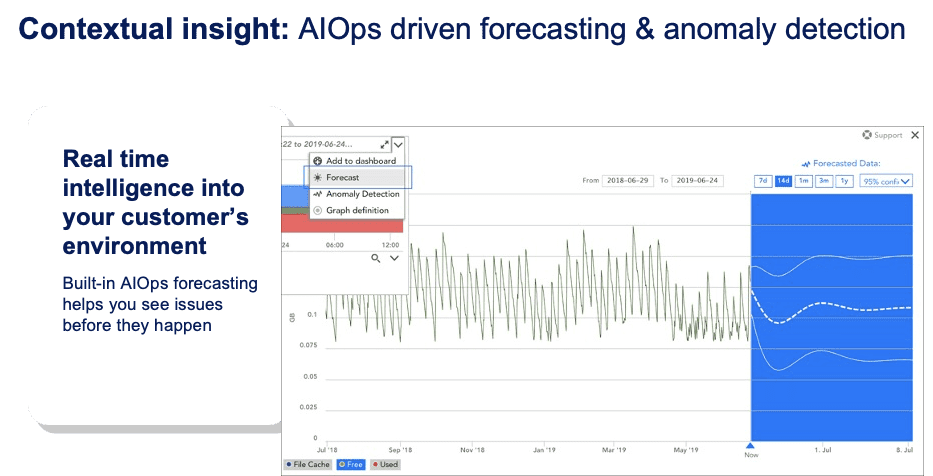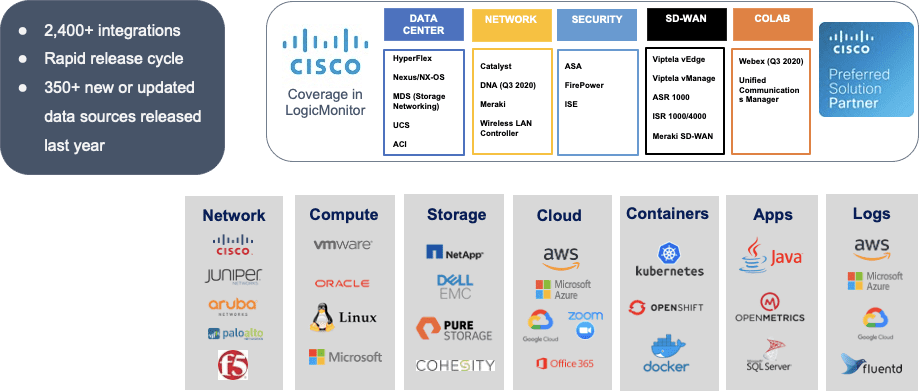As the healthcare industry has introduced more complex IT infrastructure, it now faces many challenges as it strives to deliver high-quality services to patients. From adapting to remote work and telemedicine to resource constraints, healthcare organizations must continually adapt to new technologies.
Some of the nascent technologies, like remote triage of patients, telemedicine, and IoT, have all seen an acceleration in innovation as the industry pivots to visit patients remotely. Possibilities have become reality as the healthcare industry has brought these early-stage technologies into everyday use.
These high-tech solutions require a holistic approach to monitoring that helps companies gain a comprehensive understanding of their IT systems and equipment, and how they are functioning — a solution that can look at a hybrid infrastructure (both on-prem and cloud) to minimize downtime, quickly find problems, remove irrelevant alerts, and alert the right people about issues. This approach ensures healthcare organizations avoid problems that may have a direct impact on patient outcomes.
While technological advancements have brought about new tools and shifted trends in health and sciences fields, they’ve also introduced new problems. In this blog post, we’ll look at the exciting trends we are seeing in healthcare today and also explore some of the challenges that the industry faces.
Trends in health and life sciences technology
Telemedicine and virtual care
As patients are using connected devices more, telemedicine and virtual care have become a transformative trend that makes it easy to serve patients who struggle to make it to a physical doctor’s office. Patients can talk remotely to doctors to get medical advice and use remote monitoring devices to securely send medical data.
Connected devices and IoT
Connected devices and remote sensor technology make remote medicine possible. From testing insulin levels to monitoring a patient’s heart rate, these devices allow clinicians to remotely manage chronic conditions without having to meet face-to-face with a patient.
IoT devices can generate the data needed to make better predictions about what a patient’s healthcare needs will be and therefore improve patient outcomes significantly. What you do with that data and how you analyze the data for patterns becomes the focus for improving patient care.
AI and automation for clinical assessment
AI is already being used to identify problems from scans in areas of medicine like radiology. Diagnostic error prevention and earlier diagnosis of problems are key benefits being delivered by AI. AI extends into areas like automated triage of problems and prescription handling, which takes the burden off of clinicians and allows them to focus on more advanced diagnoses and, ultimately, see more patients.
Additionally, the rise of the chatbot across all industries is helping improve initial engagement with customers and reducing costs for companies.
Virtual reality and augmented reality
AR and VR are improving clinicians’ training by providing a risk-free environment to practice complex procedures. Running through a checklist of steps in a procedure can improve operation success rates.
Virtual reality can also be a useful tool in surgery planning and discussion with patients as it allows a surgeon to describe a procedure in detail and show a patient exactly what is going to happen.
Using big data and AI to refine drug development and efficacy
Device and drug efficiency are both being improved by the use of data analytics with AI engines. This makes comparative studies significantly easier and cheaper using machine learning models to assess the effectiveness of new drugs to market or new medical devices.
AI can also identify patterns between different drugs and diseases, helping with the rapid prototyping of new drugs or new uses for existing drugs.
Challenges faced by health and life sciences organizations
Visibility and troubleshooting problems
Companies undergoing digital transformation to modernize their technology may introduce new devices that soon slip through the cracks, resulting in blind spots. Some of this is due to legacy equipment that doesn’t integrate well with modern technology—old monitoring tools may not scale well or integrate seamlessly with newer technologies. The resulting lack of visibility into IT infrastructure can lead to insufficient data, poor performance, extended downtimes, and far more time troubleshooting than should be necessary.
Increased complexity due to more tools
The number of new tools healthcare organizations use today creates much more complexity within the IT infrastructure than in the past. These tools may interact in unexpected ways, leading to increased time to resolve issues. IT teams must understand how new tools integrate and interact with each other, when these interactions happen, and how things might go wrong when something fails.
Processing too much information
An excess of new tools leads to large amounts of new data for IT teams to process. Between in-house and third-party tools, teams will need to understand where to look to find the root cause of a problem and how to avoid looking at irrelevant alerts and data. Teams need a solution that helps them quickly identify the source of problems and get the data they need to quickly resolve them.
Irrelevant alerts that take away focus from real problems
As an IT team adds more inventory to their monitoring system, they will begin getting more alerts detailing everything about those systems. Not all of those messages are relevant, and the sheer overload of alerts can cause teams to miss the real problems that may negatively impact patient care.
The LogicMonitor solution for health and life sciences
Simplified extensibility Into IoT, with support for medical technology and sensors to ensure availability and improve uptime
LogicMonitor monitors a wide variety of devices, but users can easily customize it to monitor medical apparatus and the vital sensor technologies that ensure the environment will not affect the performance of medical technology. Understanding temperature and humidity, as well as the supply of critical gases and liquids to medical equipment, allows IT teams to maintain the high availability levels expected by healthcare professionals.

LogicMonitor makes custom monitoring templates straightforward with our rapid prototyping capabilities. LogicMonitor also has a large team of professional services engineers available to help users customize their monitoring based on needs — all at a price customized to your needs instead of a huge monthly fee for features and resources you don’t use.
LogicMonitor helps you forecast and identify anomalies
The health sector is a data business, both analyzing the efficacy of treatments and new drugs and also the success of procedures and processes. LogicMonitor marries granular support for big data platforms like Hadoop with a robust AIOps engine to analyze any metrics that are fed into the platform. Bespoke monitoring templates make it easy to manage medical equipment and analyze metric data.
LogicMonitor’s AIOps features intelligently detect service-impacting signals from noise, make signals more actionable, and reduce the flurry of false alerts that keep teams up at night. With alert escalation chains, users ensure they are informing the right team members via SMS, email, chat, or ITSM integrations. LogicMonitor’s AIOps capabilities enable teams to identify the root cause of an outage and put an end to alert storms with built-in dynamic thresholds and root cause analysis.

LogicMonitor has extensive coverage across the enterprise IT landscape and into the cloud with monitoring templates for everything from SD-WAN to containers. Often, organizations are used to data silos and need their own specialist tools to monitor their network and specific technologies. LogicMonitor breaks down these silos by allowing every team to troubleshoot their problems in the same way with granular performance data for all types of infrastructure.
In addition, LogicMonitor works with the largest hospital software vendors, including Epic, Citrix, Linux, Windows, AWS, and many others.
In total, LogicMonitor offers over 2,400 integrations — with more released and updated regularly — that enable organizations to get a complete picture of their IT infrastructure, no matter what they decide to use. This allows organizations to build extensible systems that meet their unique needs.

Secure by Design
LogicMonitor’s platform is highly secure. The following are just some of the ways that LogicMonitor ensures the security of users and the platform itself.
Secure architecture
- RBAC, 2FA.
- Encryption of data in transit and at rest.
Secure data collection
- Only permitted outbound communication from LM Collector.
- Data encrypted with TLS.
- LM Collectors are securely locked to your environment.
Secure operations
- Collectors based on hardened Linux with perimeter and host-based IPS.
- Operated out of top-tier DCs and AWS regions.
- All with top security measures in place.
Secure practices
- Minimal personal data stored.
- Device access credentials stored in memory and never written to disk.
- Salted one-way hashes used in place of user passwords.
Secure standards
- Constant penetration testing ensures maximum security.
- SOC2 validates our controls for security.
- High availability and confidentiality.
In addition to LogicMonitor’s native platform, by leveraging a secure proxy, user operations teams will retain complete control of communications. This allows users to lock down traffic out of their networks to minimize exposure to external bad actors.
One platform for Hybrid Observability – metrics, logs, traces, and powerful AIOps capabilities
LogicMonitor’s service-centric dashboards provide organizations with a holistic view of their entire infrastructure and take a proactive approach to observability. IT teams can quickly surface relevant information to quickly identify issues and their root causes. LogicMonitor offers an agentless solution — you don’t need to install user agents on any resources. It will automatically find and monitor the resources on your dashboards.
These dashboards give teams information in several ways.
- Metrics – The most comprehensive monitoring platform with coverage for >2500 different technologies spanning network, cloud, containers, and applications.
- Logs – Eliminate context switching between IT infrastructure monitoring and log analysis products by correlating relevant logs with metrics in a single platform with out-of-the-box integrations (or via any custom log source).
- Traces – Never miss an application error, improve code quality, and diagnose and fix issues faster. Gain insight into the performance of the entire app stack, from code to cloud, to ensure a flawless customer experience in agile environments.
Bupa improves healthcare efficiency by streamlining IT with LogicMonitor
A great example of a successful LogicMonitor healthcare customer is Bupa. A healthcare leader in EMEA and APAC, Bupa commits to helping people live longer, healthier, happier lives. With 84,000 employees serving more than 31 million customers, the organization offers a broad range of services, including aged care and retirement, dental, optical, health insurance, and more. LogicMonitor helped Bupa to consolidate its monitoring tooling at speed and at scale, deploying to more than 500 devices in 30 minutes. Luke Williams, Head of Service Management, explained that “LogicMonitor was the best fit for what we were trying to achieve. It was the only solution that enabled us to not only consolidate but also reduce costs”.
LogicMonitor’s tight integration with ServiceNow allows Bupa to deal with outages more quickly and efficiently. Dennis Huynh, the Reporting and Monitoring Manager said, “With LogicMonitor, we have been able to successfully integrate and automate a lot of the incident creation and flag issues faster. The teams are now able to respond correctly, using the better processes, instead of spending time manually creating incidents.” Read the full Bupa case study here.
Although ever-evolving technologies have presented countless challenges to healthcare organizations, I am truly amazed at how they have not only dealt with extraordinary change but also embraced technology and innovation to advance how we treat patients and how we deal with new threats and challenges to human health. The next ten years will see some unbelievable fundamental changes to patient care and the treatment and management of diseases.
The future looks bright.
Like many industries, the pharmaceutical industry is undergoing a rapid transformation powered by technology. These technologies allow companies to improve business operations and empower the innovation needed to be competitive in today’s market. For pharmaceutical companies, time to market a new product can be costly and time-consuming. In this complex and regulated industry, it can take over a decade to bring a new therapy to market, while costs can total over $2 billion. Because of this, any efficiency that can be introduced throughout the product development life cycle can result in invaluable savings in terms of time and money.
Technologies that previously have been associated with cutting-edge tech companies – such as blockchain, data warehousing, and artificial intelligence – are now being put into use by more traditional industries, including pharmaceutical companies. These technologies enable companies to become more agile and efficient throughout the product life cycle, providing an advantage over competitors who have not yet embraced these advancements to their full potential. Additionally, many pharmaceutical companies are interacting more with patients, with the development of patient-facing digital initiatives such as mobile apps, wearable devices, and even eCommerce websites.
Building IT Environments to Support Digital Transformation Initiatives
While a digital-first approach has many benefits, the underlying IT infrastructure required to support this shift has to be agile, scalable, and reliable. Technologies such as cloud, containers, and SD-WAN unlock the ability of pharmaceutical companies to eliminate inefficiencies and replace outdated business processes with streamlined digital-driven versions.
As pharmaceutical organizations become more reliant on digital technologies to support various areas of the business, uptime becomes increasingly paramount. However, the more complex your infrastructure becomes, the more the likelihood of outages or brownouts increases. An outage of even a few short minutes can cause disruptions that have large impacts in terms of lost revenue, productivity, and reputation. By building a reliable infrastructure coupled with comprehensive monitoring, you can rest assured that necessary workflows will be supported across the organization.
Why SaaS Monitoring Is Essential to Digital Transformation Initiatives
Legacy tools often rely on on-premise infrastructure and can be difficult to scale across new technologies as quickly as today’s modern enterprises require, and many IT teams are left with areas in their IT stack that are not adequately monitored. It is more difficult to anticipate and resolve issues when you do not have full visibility of all systems or if you are constantly moving between multiple systems.
SaaS monitoring provides the agility and extensibility needed to cover any new technologies easily, while automatic updates mean little maintenance is required for the tool itself – freeing your teams to focus on strategic initiatives. The flexibility of a SaaS platform also means that you can future-proof your monitoring and support any future changes necessary for your organization’s digital transformation. Infrastructure monitoring can easily be forgotten when building out a digital transformation strategy. Including it in your plans will ensure your infrastructure is reliable and scalable as your company grows.
Learn more about how LogicMonitor is helping pharmaceutical companies unlock the power of digital transformation.
